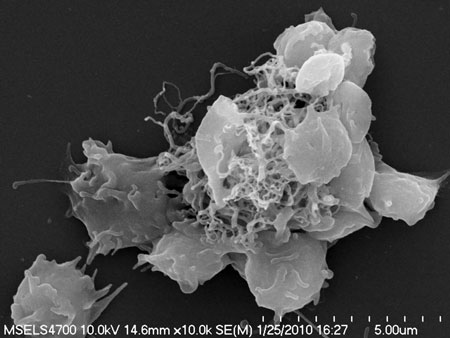| Posted: Jul 07, 2011 | |
New study reveals molecular mechanism of carbon nanotubes' role in arterial thrombosis |
|
| (Nanowerk Spotlight) Blood platelets are the structural and chemical foundation of blood clotting (hemostasis) and they play a vital role in minor injuries when coagulation prevents the loss of blood at the injury site. If the proper function of these platelets gets disturbed, blood clotting can lead to thrombosis – clots in the blood that obstruct the flow of blood through the circulatory system – which is a leading cause of death and disability in the developed world. | |
| "In view of the rapid development of nanotechnology, the impact of the newly engineered nanomaterials as an additional thrombosis risk factor is not yet known but should not be underestimated," Jan Simak, a Senior Staff fellow at the U.S. Food and Drug Administration's Center for Biologics Evaluation and Research (CBER), tells Nanowerk. "In fact, it has been reported that carbon nanotubes induce platelet aggregation and potentiate arterial thrombosis in animal model. However, a mechanism of thrombogenic effects of carbon nanotubes was not known." (see :"Nanoparticle-induced platelet aggregation and vascular thrombosis") | |
| In a recent paper in ACS Nano ("Carbon Nanotubes Activate Store-Operated Calcium Entry in Human Blood Platelets"), Simak and a team of researchers from the FDA, the National Institute of Standards and Technology (NIST,the National Institutes of Health (NIH), and Charles University in Prague, show the molecular mechanism of carbon nanotubes' (CNTs) induced platelets activation. | |
 |
|
| Scanning electron microscopy image shows platelet activation by multiwallled CNTs (M60). Platelets were incubated with 100 µg/mL of M60 at 37°C for 15 minutes under gentle agitation. The images are representative of at least three individual experiments with platelets from different donors. (Image: Jan Simak, FDA) | |
| In previous work ("Carbon Nanotubes Activate Blood Platelets by Inducing Extracellular Ca2+ Influx Sensitive to Calcium Entry Inhibitors"), the team has already shown that multiwalled CNTs activate blood platelets by inducing extracellular Ca2+ influx. | |
| Given that CNTs are under discussion for a variety of applications in biomedicine – diagnostic biosensors, drug delivery nanosystems, imaging nanoprobes for intravascular use and other devices that come in contact with blood – the assessment of the effect of CNTs in blood is a critical safety issue. | |
| In their new work, the team elucidates the mechanism involved in activation of blood platelets by carbon nanotubes. | |
| Silvia H. De Paoli Lacerda, a researcher at CBER and the paper's first author, explains that, in contrast to fullerene nC60, which does not activate platelets, CNTs act as 'nanoneedles' – they perforate platelets and cause injuries to the platelet dense tubular systems (DTS). | |
| "The DTS serves as an intracellular Ca2+ store in blood platelets and upon interaction with CNTs, Ca2+ is released to the cytosol," she says. "Depletion of Ca2+ from DTS leads to the extracellular Ca2+ influx via store-operated calcium entry (SOCE). The SOCE activation is triggered by clustering of a Ca2+ sensing protein STIM1 co-localized with Orai1." | |
| The researchers have now demonstrated that CNTs activate SOCE – which ultimately leads to the platelet activation and aggregation. At the same time, they also showed that some Ca2+ channel blockers inhibit platelet activating activity of CNTs. | |
| According to Simak, this finding opens a possibility of pharmacological modulation of the thrombogenic activity of CNTs. | |
| "Also, the structure of nanomaterial agglomerates play an important role on their effect on platelet function: CNT agglomerates with a hedgehog like surface activate platelets while nC60 agglomerates with a smooth surface do not" he says. "Thus, structural studies on the shape of nanomaterials may lead to optimization of their biocompatibility in blood." | |
| Understanding the nature of the interaction of CNTs with platelets will ultimately advance the development of general concepts for designing and testing carbon nanomaterials for optimal biocompatibility in blood. In particular, researchers need to understand how CNTs interact with other blood components and with vessel wall. | |
| The next step for the team is to investigate how surface modifications of CNTs modulate their blood and vascular biocompatibility. | |
| Simak points out that one great challenge in these studies is the lack of standard protocols for characterization of nanomaterials and analysis of impurities in published reports. | |
| "For nanomaterials insoluble in aqueous solutions, it is critical how the nanomaterial suspensions in buffer are prepared and how the nanomaterial agglomeration is controlled and monitored during in vitro or in vivo biological experiments," he says. "Standardization of such protocols would allow interlaboratory comparison of results of biocompatibility and toxicity studies." | |
| Disclaimer: The findings and conclusions in this article have not been formally disseminated by the Food and Drug Administration and should not be construed to represent any Agency determination or policy. | |
 By
Michael
Berger
– Michael is author of three books by the Royal Society of Chemistry:
Nano-Society: Pushing the Boundaries of Technology,
Nanotechnology: The Future is Tiny, and
Nanoengineering: The Skills and Tools Making Technology Invisible
Copyright ©
Nanowerk LLC
By
Michael
Berger
– Michael is author of three books by the Royal Society of Chemistry:
Nano-Society: Pushing the Boundaries of Technology,
Nanotechnology: The Future is Tiny, and
Nanoengineering: The Skills and Tools Making Technology Invisible
Copyright ©
Nanowerk LLC
|
|
|
Become a Spotlight guest author! Join our large and growing group of guest contributors. Have you just published a scientific paper or have other exciting developments to share with the nanotechnology community? Here is how to publish on nanowerk.com. |
|
